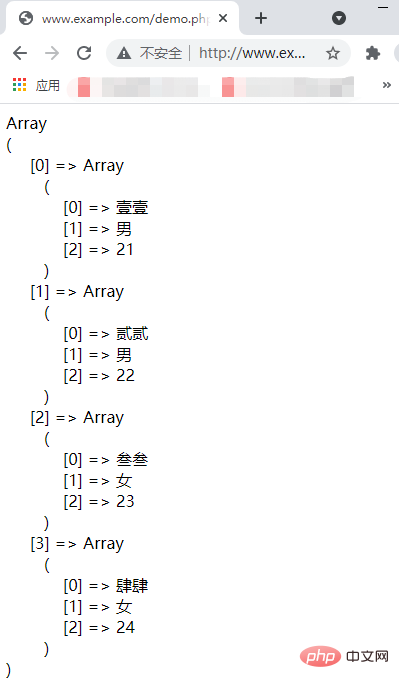Usage of mysqli_select_db and mysqli_query functions in PHP
In the previous article, I brought you "How to connect to the MySQL database in PHP? ", which introduces in detail how to connect to the MySQL database in PHP. In this article, we take a look at the relevant knowledge of PHP using the mysqli_select_db() function to select a database. I hope everyone has to help!

As mentioned in the previous article, PHP can connect to the MySQL database through the mysqli_connect() function. One parameter of this function is the name of the corresponding database. , this parameter is an optional parameter and can be omitted. If you omit this parameter, you need to specify a default database later. In PHP, you can specify a default database through the mysqli_select_db() function. Then let’s take a look at the usage of this function.
<strong><span style="font-size: 20px;">mysqli_select_db()</span></strong>Function
The syntax of this function The format is also divided into two situations. One is the object-oriented writing method, and its syntax format is as follows:
mysqli::select_db(string $dbname)
where $dbname represents the specified database name, and the other The first is a process-oriented writing method, and its syntax format is as follows:
mysqli_select_db(mysqli $link, string $dbname)
It should be noted that:
$dbnameis still expressed as specified Database name,$linkrepresents the database connection returned by the mysqli_connect() function.
If the function is successfully executed, the return result is true. If the function fails, the return result is false.
Next, let’s take an example to see how to select a database through the mysqli_select_db() function. The example is as follows:
<?php
$host = 'localhost';
$username = 'root';
$password = 'root';
$dbname = 'test';
$mysql = new Mysqli($host, $username, $password);
if($mysql -> connect_errno){
die('数据库连接失败:'.$mysql->connect_errno);
}else{
$mysql -> select_db($dbname); // 选择名为 test 的数据库
$sql = 'select name,sex,age from user'; // SQL 语句
$result = $mysql -> query($sql); // 执行上面的 SQL 语句
$data = $result -> fetch_all();
$mysql -> close();
}
echo '<pre class="brush:php;toolbar:false">';
print_r($data);
?>The above example selects a database named “test” through the mysqli_select_db() function. ” database, the output results are as follows:

The above example uses object-oriented writing. Next, let’s take a look at what process-oriented writing looks like. Example As follows:
<?php
$host = 'localhost';
$username = 'root';
$password = 'root';
$dbname = 'test';
$link = @mysqli_connect($host, $username, $password);
if($link){
mysqli_select_db($link, $dbname); // 选择名为 test 的数据库
$sql = 'select name,sex,age from user'; // SQL 语句
$result = mysqli_query($link, $sql); // 执行 SQL 语句,并返回结果
$data = mysqli_fetch_all($result); // 从结果集中获取所有数据
mysqli_close($link);
}else{
echo '数据库连接失败!';
}
echo '<pre class="brush:php;toolbar:false">';
print_r($data);
?>In the above example, the difference between the two writing methods is not big, and the output results are the same. From this we specify a default database through the mysqli_select_db() function. Then let's take a look at the mysqli_query() function. What does it do and how is it used?
<strong><span style="font-size: 20px;">mysqli_query()</span></strong>## Function
mysqli_query() function. The syntax format of this function is as follows:
mysqli::query( string $query [, int $resultmode = MYSQLI_STORE_RESULT ] )
$query
represents the SQL statement to be executed;$resultmode
is an optional parameter, used to modify the behavior of the function.
mysqli_query( mysqli $link , string $query [, int $resultmode = MYSQLI_STORE_RESULT ] )
$link
Represents the database connection returned by the mysqli_connect() function;$query
Represents the SQL statement to be executed;$resultmode
is an optional parameter used to modify the behavior of the function.
mysql> select * from user;First of all, let’s take a look at the object-oriented writing method. The example is as follows :---- -------- ------ ------
| id | name | age | sex |
---- -------- ------ ------
| 1 | 一一 | 21 | Male |
| 2 | 二二 | 22 | Male |
| 3 | Sansan | 23 | Female |
| 4 | Four Four | 24 | Female |
---- --- ----- ------ ------
4 rows in set (0.00 sec)
<?php
$host = 'localhost';
$username = 'root';
$password = 'root';
$dbname = 'test';
$mysql = new Mysqli($host, $username, $password, $dbname);
if($mysql -> connect_errno){
die('数据库连接失败:'.$mysql->connect_errno);
}else{
$mysql -> set_charset('UTF-8'); // 设置数据库字符集
$sql = 'select name,sex,age from user'; // SQL 语句
$result = $mysql -> query($sql); // 执行上面的 SQL 语句
$data = $result -> fetch_all();
$mysql -> close();
}
echo '<pre class="brush:php;toolbar:false">';
print_r($data);
?>
<?php
$host = 'localhost';
$username = 'root';
$password = 'root';
$dbname = 'test';
$link = @mysqli_connect($host, $username, $password, $dbname);
if($link){
$sql = 'select name,sex,age from user'; // SQL 语句
$result = mysqli_query($link, $sql); // 执行 SQL 语句,并返回结果
$data = mysqli_fetch_all($result); // 从结果集中获取所有数据
mysqli_close($link);
}else{
echo '数据库连接失败!';
}
echo '<pre class="brush:php;toolbar:false">';
print_r($data);
?>If you are interested, you can click on "PHP Video Tutorial" to learn more about PHP knowledge.
The above is the detailed content of Usage of mysqli_select_db and mysqli_query functions in PHP. For more information, please follow other related articles on the PHP Chinese website!

Hot AI Tools

Undresser.AI Undress
AI-powered app for creating realistic nude photos

AI Clothes Remover
Online AI tool for removing clothes from photos.

Undress AI Tool
Undress images for free

Clothoff.io
AI clothes remover

Video Face Swap
Swap faces in any video effortlessly with our completely free AI face swap tool!

Hot Article

Hot Tools

Notepad++7.3.1
Easy-to-use and free code editor

SublimeText3 Chinese version
Chinese version, very easy to use

Zend Studio 13.0.1
Powerful PHP integrated development environment

Dreamweaver CS6
Visual web development tools

SublimeText3 Mac version
God-level code editing software (SublimeText3)

Hot Topics
 1664
1664
 14
14
 1423
1423
 52
52
 1318
1318
 25
25
 1269
1269
 29
29
 1248
1248
 24
24
 MySQL and phpMyAdmin: Core Features and Functions
Apr 22, 2025 am 12:12 AM
MySQL and phpMyAdmin: Core Features and Functions
Apr 22, 2025 am 12:12 AM
MySQL and phpMyAdmin are powerful database management tools. 1) MySQL is used to create databases and tables, and to execute DML and SQL queries. 2) phpMyAdmin provides an intuitive interface for database management, table structure management, data operations and user permission management.
 Explain the purpose of foreign keys in MySQL.
Apr 25, 2025 am 12:17 AM
Explain the purpose of foreign keys in MySQL.
Apr 25, 2025 am 12:17 AM
In MySQL, the function of foreign keys is to establish the relationship between tables and ensure the consistency and integrity of the data. Foreign keys maintain the effectiveness of data through reference integrity checks and cascading operations. Pay attention to performance optimization and avoid common errors when using them.
 The Compatibility of IIS and PHP: A Deep Dive
Apr 22, 2025 am 12:01 AM
The Compatibility of IIS and PHP: A Deep Dive
Apr 22, 2025 am 12:01 AM
IIS and PHP are compatible and are implemented through FastCGI. 1.IIS forwards the .php file request to the FastCGI module through the configuration file. 2. The FastCGI module starts the PHP process to process requests to improve performance and stability. 3. In actual applications, you need to pay attention to configuration details, error debugging and performance optimization.
 Compare and contrast MySQL and MariaDB.
Apr 26, 2025 am 12:08 AM
Compare and contrast MySQL and MariaDB.
Apr 26, 2025 am 12:08 AM
The main difference between MySQL and MariaDB is performance, functionality and license: 1. MySQL is developed by Oracle, and MariaDB is its fork. 2. MariaDB may perform better in high load environments. 3.MariaDB provides more storage engines and functions. 4.MySQL adopts a dual license, and MariaDB is completely open source. The existing infrastructure, performance requirements, functional requirements and license costs should be taken into account when choosing.
 What happens if session_start() is called multiple times?
Apr 25, 2025 am 12:06 AM
What happens if session_start() is called multiple times?
Apr 25, 2025 am 12:06 AM
Multiple calls to session_start() will result in warning messages and possible data overwrites. 1) PHP will issue a warning, prompting that the session has been started. 2) It may cause unexpected overwriting of session data. 3) Use session_status() to check the session status to avoid repeated calls.
 SQL vs. MySQL: Clarifying the Relationship Between the Two
Apr 24, 2025 am 12:02 AM
SQL vs. MySQL: Clarifying the Relationship Between the Two
Apr 24, 2025 am 12:02 AM
SQL is a standard language for managing relational databases, while MySQL is a database management system that uses SQL. SQL defines ways to interact with a database, including CRUD operations, while MySQL implements the SQL standard and provides additional features such as stored procedures and triggers.
 Composer: Aiding PHP Development Through AI
Apr 29, 2025 am 12:27 AM
Composer: Aiding PHP Development Through AI
Apr 29, 2025 am 12:27 AM
AI can help optimize the use of Composer. Specific methods include: 1. Dependency management optimization: AI analyzes dependencies, recommends the best version combination, and reduces conflicts. 2. Automated code generation: AI generates composer.json files that conform to best practices. 3. Improve code quality: AI detects potential problems, provides optimization suggestions, and improves code quality. These methods are implemented through machine learning and natural language processing technologies to help developers improve efficiency and code quality.
 MySQL: The Database, phpMyAdmin: The Management Interface
Apr 29, 2025 am 12:44 AM
MySQL: The Database, phpMyAdmin: The Management Interface
Apr 29, 2025 am 12:44 AM
MySQL and phpMyAdmin can be effectively managed through the following steps: 1. Create and delete database: Just click in phpMyAdmin to complete. 2. Manage tables: You can create tables, modify structures, and add indexes. 3. Data operation: Supports inserting, updating, deleting data and executing SQL queries. 4. Import and export data: Supports SQL, CSV, XML and other formats. 5. Optimization and monitoring: Use the OPTIMIZETABLE command to optimize tables and use query analyzers and monitoring tools to solve performance problems.




